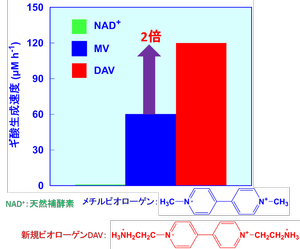Research Results
Aug 3, 2017
- Press Release
- Research Paper
A press release announcing the research findings of rof. Yutaka Amao's group has been issued
Through the development of a new artificial coenzyme, we have achieved significant advancements in the efficiency of photocatalytically reducing carbon dioxide into formic acid.
This research presentation was introduced in the following media.
- 8/3 The Chemical Daily
Professor Yutaka Amao of the Research Center for Artificial Photosynthesis and Project Assistant Professor Shusaku Ikeyama (The OCU Advanced Research Institute for Natural Science and Technology) have developed a new artificial coenzyme by introducing two amino groups (-NH2) into the viologen structure, significantly enhancing the efficiency of photocatalytic carbon dioxide reduction to formic acid. The research team held a press conference on August 1, 2017, to announce this groundbreaking achievement.

Prof. Amao explains his research

Press conference
Outline of Research
A key technology for creating artificial photosynthesis systems that convert carbon dioxide into organic molecules using solar energy is the development of efficient catalysts. Our research team has significantly enhanced the activity of formate dehydrogenase, a catalyst for converting carbon dioxide to formic acid (a fuel, chemical product, and energy storage medium), by employing a newly synthesized artificial coenzyme. This novel coenzyme, featuring two amino groups (-NH2) attached to a viologen structure (DAV in the figure), has demonstrated an unprecedented 560-fold increase in catalytic activity compared to natural coenzymes.

By incorporating the newly synthesized artificial coenzyme into a photoredox system composed of a water-soluble porphyrin dye and formate dehydrogenase, we have significantly enhanced the rate of carbon dioxide reduction to formic acid. After one hour of visible light irradiation, the system exhibited a two-fold increase in formic acid production compared to systems using methyl viologen, setting a new benchmark in the field.
We believe that this breakthrough will play a pivotal role in advancing the development of catalysts for artificial photosynthesis, enabling the efficient conversion of carbon dioxide into organic molecules. Our ongoing research focuses on optimizing reaction conditions to further enhance formic acid production.
Publication Information
| Publications: | Sustainable Energy & Fuels |
|---|---|
| Title of Paper: | A novel electron carrier molecule based on viologen derivative for visible light-driven CO2 reduction to formic acid with the system of zinc porphyrin and formate dehydrogenase |
| Author: | Shusaku Ikeyama, Yutaka Amao |
| URL: | https://doi.org/10.1039/C7SE00255F |